FIFA World Cup: Tourism & Impact
VerifiedAdded on 2020/02/19
|14
|3793
|45
AI Summary
This assignment requires an in-depth analysis of the 2014 FIFA World Cup's effects on various aspects like tourism, a country's reputation, and social media engagement. Students are expected to examine provided research papers that delve into these themes, drawing insights from data and scholarly perspectives. The analysis should focus on understanding how the event shaped perceptions, travel patterns, and online conversations surrounding the tournament.
Contribute Materials
Your contribution can guide someone’s learning journey. Share your
documents today.
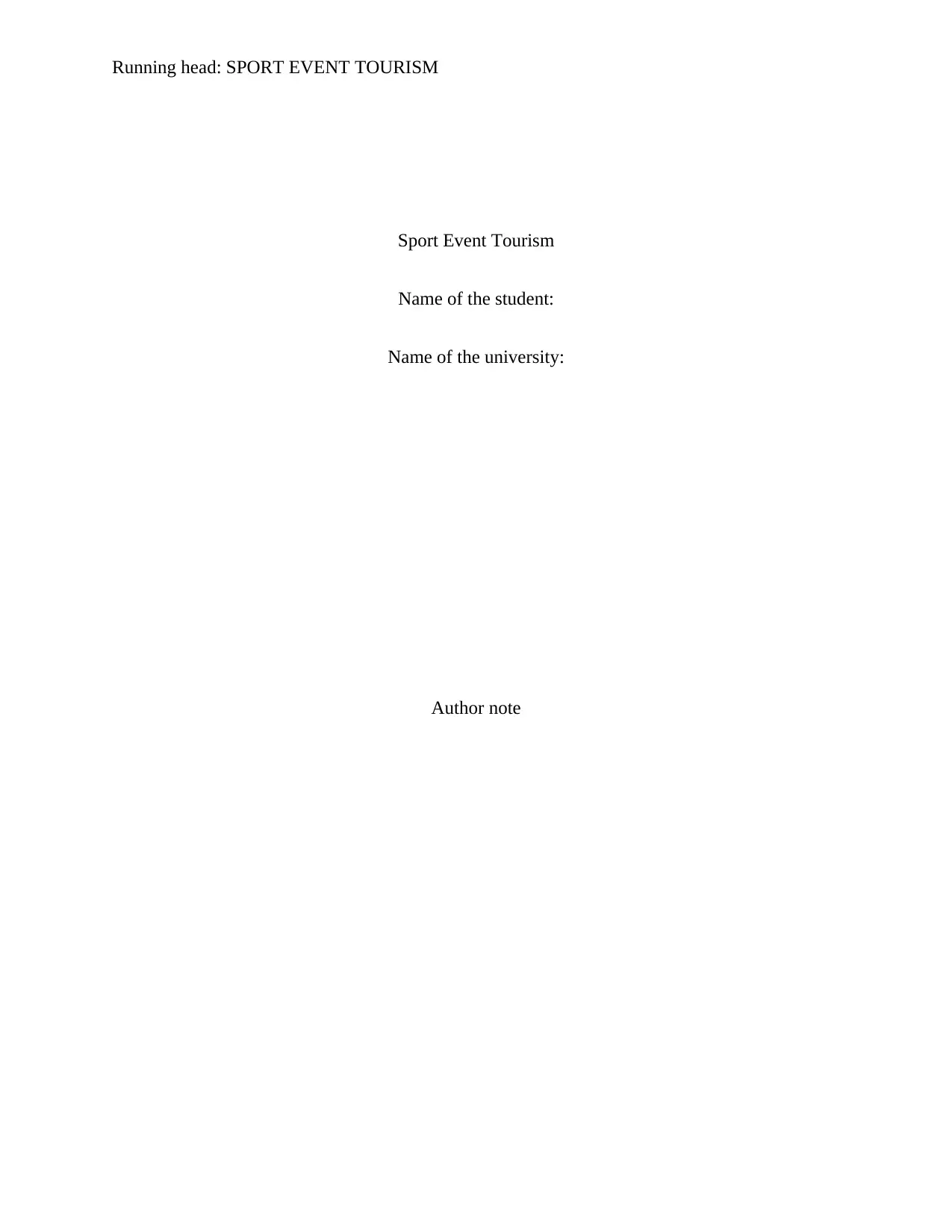
Running head: SPORT EVENT TOURISM
Sport Event Tourism
Name of the student:
Name of the university:
Author note
Sport Event Tourism
Name of the student:
Name of the university:
Author note
Secure Best Marks with AI Grader
Need help grading? Try our AI Grader for instant feedback on your assignments.
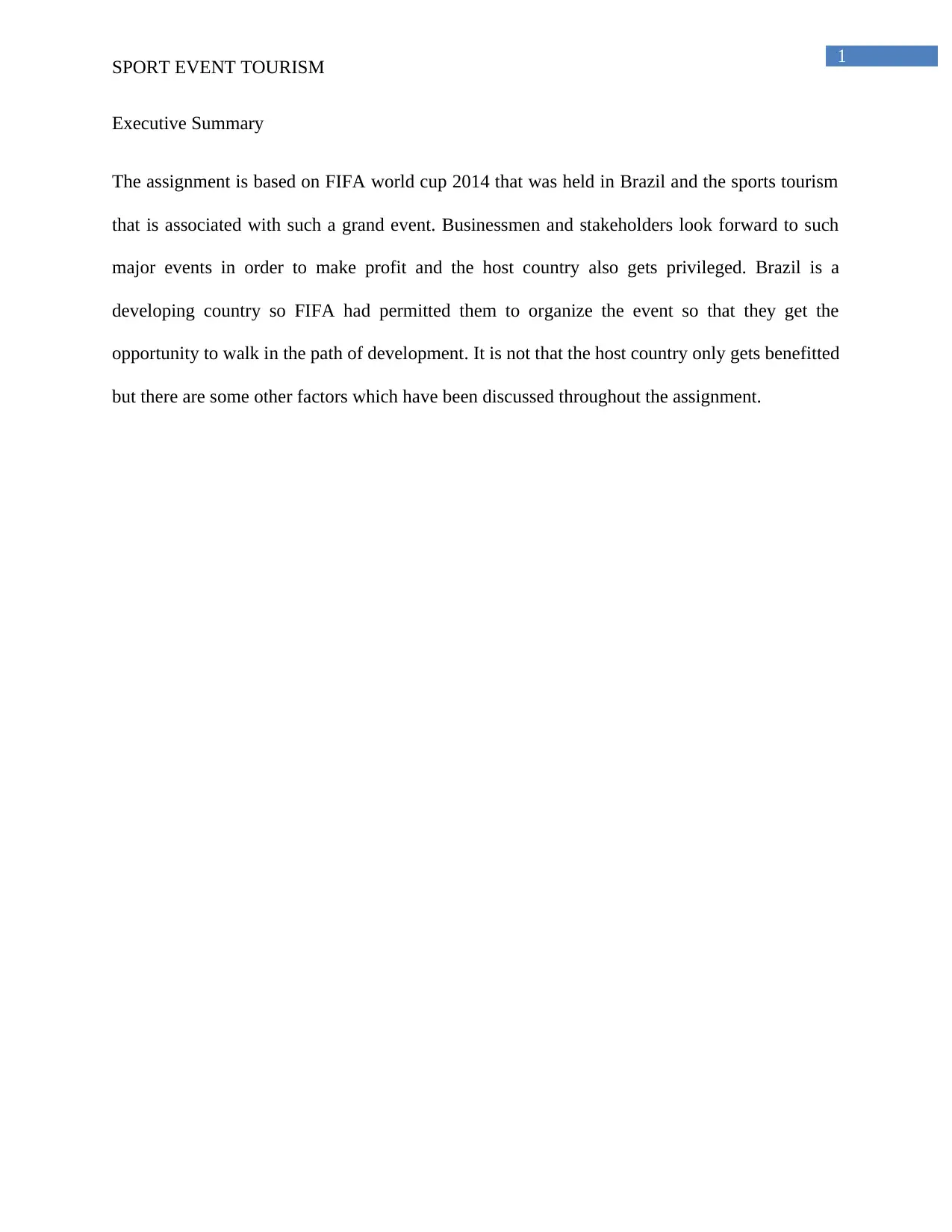
1
SPORT EVENT TOURISM
Executive Summary
The assignment is based on FIFA world cup 2014 that was held in Brazil and the sports tourism
that is associated with such a grand event. Businessmen and stakeholders look forward to such
major events in order to make profit and the host country also gets privileged. Brazil is a
developing country so FIFA had permitted them to organize the event so that they get the
opportunity to walk in the path of development. It is not that the host country only gets benefitted
but there are some other factors which have been discussed throughout the assignment.
SPORT EVENT TOURISM
Executive Summary
The assignment is based on FIFA world cup 2014 that was held in Brazil and the sports tourism
that is associated with such a grand event. Businessmen and stakeholders look forward to such
major events in order to make profit and the host country also gets privileged. Brazil is a
developing country so FIFA had permitted them to organize the event so that they get the
opportunity to walk in the path of development. It is not that the host country only gets benefitted
but there are some other factors which have been discussed throughout the assignment.

2
SPORT EVENT TOURISM
Introduction
Adidas was one of the key partners of FIFA world cup 2014 which was held in Brazil.
‘Creating the new’ is the tagline for their next five- year strategic business plan. This attitude has
led them to their current position and will pave the way for an exciting future. This is because the
industry of sports tourism products is expanding and will continue to do so. It is expanding at a
rapid speed as compared to other industries which includes consumer electronics too. Sports
form the centre of all culture and society and the root to an individual’s health and happiness.
This is an excellent platform for Adidas because they will get the opportunity to excel in their
business. They have become successful in changing the lives of people through their power in
sports. They work hard to inspire and motivate people to indulge in sporting activities. They are
also successful in transferring their competence in sports into fashion, style statement and street
wear as they believe that sports are life and attitude. Their mission and vision is totally aimed at
sports (Billings, Burch and Zimmerman 2015).
The event
It was the 20th FIFA world cup that was held in Brazil in 2014. The one- month long
event was held after Pele’s country was permitted to organize the event. Thirty-one teams went
forward for the qualifying rounds to join the host country in the final show. 64 matches were
played in total 12 venues of Brazil. It was the first time in an event that the officials used goal-
line technology and vanishing foam for free kicks. The gathering for the grand event crossed 1
million who came from 202 different countries. All the popular and world- cup winning teams
had qualified for the match. In the semi- final the host nation had to bid farewell after losing to
Germany who played against Argentina in the final (Clemente et al. 2015). The match against
SPORT EVENT TOURISM
Introduction
Adidas was one of the key partners of FIFA world cup 2014 which was held in Brazil.
‘Creating the new’ is the tagline for their next five- year strategic business plan. This attitude has
led them to their current position and will pave the way for an exciting future. This is because the
industry of sports tourism products is expanding and will continue to do so. It is expanding at a
rapid speed as compared to other industries which includes consumer electronics too. Sports
form the centre of all culture and society and the root to an individual’s health and happiness.
This is an excellent platform for Adidas because they will get the opportunity to excel in their
business. They have become successful in changing the lives of people through their power in
sports. They work hard to inspire and motivate people to indulge in sporting activities. They are
also successful in transferring their competence in sports into fashion, style statement and street
wear as they believe that sports are life and attitude. Their mission and vision is totally aimed at
sports (Billings, Burch and Zimmerman 2015).
The event
It was the 20th FIFA world cup that was held in Brazil in 2014. The one- month long
event was held after Pele’s country was permitted to organize the event. Thirty-one teams went
forward for the qualifying rounds to join the host country in the final show. 64 matches were
played in total 12 venues of Brazil. It was the first time in an event that the officials used goal-
line technology and vanishing foam for free kicks. The gathering for the grand event crossed 1
million who came from 202 different countries. All the popular and world- cup winning teams
had qualified for the match. In the semi- final the host nation had to bid farewell after losing to
Germany who played against Argentina in the final (Clemente et al. 2015). The match against
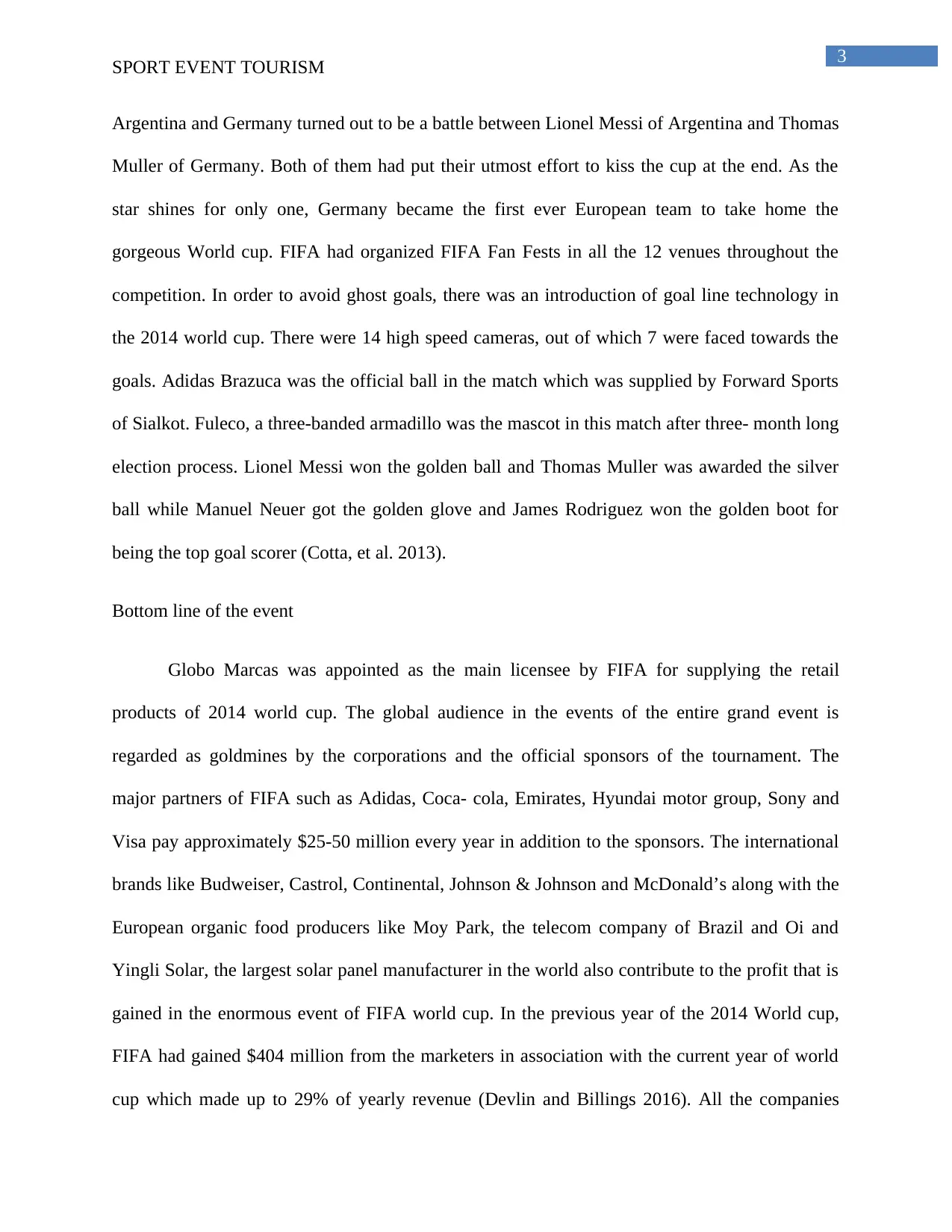
3
SPORT EVENT TOURISM
Argentina and Germany turned out to be a battle between Lionel Messi of Argentina and Thomas
Muller of Germany. Both of them had put their utmost effort to kiss the cup at the end. As the
star shines for only one, Germany became the first ever European team to take home the
gorgeous World cup. FIFA had organized FIFA Fan Fests in all the 12 venues throughout the
competition. In order to avoid ghost goals, there was an introduction of goal line technology in
the 2014 world cup. There were 14 high speed cameras, out of which 7 were faced towards the
goals. Adidas Brazuca was the official ball in the match which was supplied by Forward Sports
of Sialkot. Fuleco, a three-banded armadillo was the mascot in this match after three- month long
election process. Lionel Messi won the golden ball and Thomas Muller was awarded the silver
ball while Manuel Neuer got the golden glove and James Rodriguez won the golden boot for
being the top goal scorer (Cotta, et al. 2013).
Bottom line of the event
Globo Marcas was appointed as the main licensee by FIFA for supplying the retail
products of 2014 world cup. The global audience in the events of the entire grand event is
regarded as goldmines by the corporations and the official sponsors of the tournament. The
major partners of FIFA such as Adidas, Coca- cola, Emirates, Hyundai motor group, Sony and
Visa pay approximately $25-50 million every year in addition to the sponsors. The international
brands like Budweiser, Castrol, Continental, Johnson & Johnson and McDonald’s along with the
European organic food producers like Moy Park, the telecom company of Brazil and Oi and
Yingli Solar, the largest solar panel manufacturer in the world also contribute to the profit that is
gained in the enormous event of FIFA world cup. In the previous year of the 2014 World cup,
FIFA had gained $404 million from the marketers in association with the current year of world
cup which made up to 29% of yearly revenue (Devlin and Billings 2016). All the companies
SPORT EVENT TOURISM
Argentina and Germany turned out to be a battle between Lionel Messi of Argentina and Thomas
Muller of Germany. Both of them had put their utmost effort to kiss the cup at the end. As the
star shines for only one, Germany became the first ever European team to take home the
gorgeous World cup. FIFA had organized FIFA Fan Fests in all the 12 venues throughout the
competition. In order to avoid ghost goals, there was an introduction of goal line technology in
the 2014 world cup. There were 14 high speed cameras, out of which 7 were faced towards the
goals. Adidas Brazuca was the official ball in the match which was supplied by Forward Sports
of Sialkot. Fuleco, a three-banded armadillo was the mascot in this match after three- month long
election process. Lionel Messi won the golden ball and Thomas Muller was awarded the silver
ball while Manuel Neuer got the golden glove and James Rodriguez won the golden boot for
being the top goal scorer (Cotta, et al. 2013).
Bottom line of the event
Globo Marcas was appointed as the main licensee by FIFA for supplying the retail
products of 2014 world cup. The global audience in the events of the entire grand event is
regarded as goldmines by the corporations and the official sponsors of the tournament. The
major partners of FIFA such as Adidas, Coca- cola, Emirates, Hyundai motor group, Sony and
Visa pay approximately $25-50 million every year in addition to the sponsors. The international
brands like Budweiser, Castrol, Continental, Johnson & Johnson and McDonald’s along with the
European organic food producers like Moy Park, the telecom company of Brazil and Oi and
Yingli Solar, the largest solar panel manufacturer in the world also contribute to the profit that is
gained in the enormous event of FIFA world cup. In the previous year of the 2014 World cup,
FIFA had gained $404 million from the marketers in association with the current year of world
cup which made up to 29% of yearly revenue (Devlin and Billings 2016). All the companies
Secure Best Marks with AI Grader
Need help grading? Try our AI Grader for instant feedback on your assignments.

4
SPORT EVENT TOURISM
mentioned above have a place in the website of FIFA and in their promotional materials.
According to authentic source, it is reported that the investment by companies have increased by
40% in four years from 2010- 14.
Target segment
It is hard for the authorities to win over the consumers and it is even harder to retain
them. It is a totally new area of online consumer behavior in the recent years. Only the traditional
form of market research has the ability to tell in this complex world of several platforms. For this
reason the company SingTel had integrated its entire suite of analytics capabilities to provide the
advertisers with a holistic viewpoint of consumer behavior during the 2014 FIFA World Cup.
Being in the front line of broadcasters in the World Cup, the SingTel had intended to realize the
behavior of the consumers by deducing at home, outside home and online (Gibson 2017). These
ideas benefitted the advertisers as they were able to improve their marketing strategies,
calculating their ROI and the activation and promotional investments in the world cup and
recognize the promotional opportunities in the future on the basis of the behavior of their target
audience during FIFA 2014. As the event was screened at the community centers, clubs, cafes,
bars and restaurants, the analytics was in a special position to observe the real-time location data
for understanding the demographics and habits of the viewers.
Competitor analysis through 4Ps
ICC and IOC are regarded as the competitors of FIFA. It is important to identify the
current and future competitors in the market by analyzing the target ‘products’. It is also
important to know the preference of consumers by recognizing their direct and indirect
competition (Gibson et al. 2014). By knowing the market share of competitors, it will become
SPORT EVENT TOURISM
mentioned above have a place in the website of FIFA and in their promotional materials.
According to authentic source, it is reported that the investment by companies have increased by
40% in four years from 2010- 14.
Target segment
It is hard for the authorities to win over the consumers and it is even harder to retain
them. It is a totally new area of online consumer behavior in the recent years. Only the traditional
form of market research has the ability to tell in this complex world of several platforms. For this
reason the company SingTel had integrated its entire suite of analytics capabilities to provide the
advertisers with a holistic viewpoint of consumer behavior during the 2014 FIFA World Cup.
Being in the front line of broadcasters in the World Cup, the SingTel had intended to realize the
behavior of the consumers by deducing at home, outside home and online (Gibson 2017). These
ideas benefitted the advertisers as they were able to improve their marketing strategies,
calculating their ROI and the activation and promotional investments in the world cup and
recognize the promotional opportunities in the future on the basis of the behavior of their target
audience during FIFA 2014. As the event was screened at the community centers, clubs, cafes,
bars and restaurants, the analytics was in a special position to observe the real-time location data
for understanding the demographics and habits of the viewers.
Competitor analysis through 4Ps
ICC and IOC are regarded as the competitors of FIFA. It is important to identify the
current and future competitors in the market by analyzing the target ‘products’. It is also
important to know the preference of consumers by recognizing their direct and indirect
competition (Gibson et al. 2014). By knowing the market share of competitors, it will become

5
SPORT EVENT TOURISM
easy for the ‘promotion’ of the product. A small market research will find out the reason for sale
in competition. The strengths and weaknesses will remain unknown until the idea of market
share is gained. Planning and executing the proper strategies is beneficial for remaining in the
competition or leaving the competitors behind. Either the same strategies can be used or new
strategies can be introduced to make an impact on the ‘pricing’. Making a competition portfolio
helps in identifying all the products of competitors, their logistics, tangible and intangible
features and other services. At the same time, it is essential to prepare a suitable ‘place’ where
the product can be used for sale and that will lead to its growth and expansion. A follow up is
required for the qualitative and quantitative measures of the strategies (Hallmann, Dallmeyer and
Breuer 2014).
SWOT analysis
FIFA, the governing body of soccer, is responsible for arranging the most spectacular
sporting event in the planet, the Football World Cup. The event is targeted to all football lovers
irrespective of the age and gender. They have been successfully organizing the Football World
Cup for the last 80 years.
SPORT EVENT TOURISM
easy for the ‘promotion’ of the product. A small market research will find out the reason for sale
in competition. The strengths and weaknesses will remain unknown until the idea of market
share is gained. Planning and executing the proper strategies is beneficial for remaining in the
competition or leaving the competitors behind. Either the same strategies can be used or new
strategies can be introduced to make an impact on the ‘pricing’. Making a competition portfolio
helps in identifying all the products of competitors, their logistics, tangible and intangible
features and other services. At the same time, it is essential to prepare a suitable ‘place’ where
the product can be used for sale and that will lead to its growth and expansion. A follow up is
required for the qualitative and quantitative measures of the strategies (Hallmann, Dallmeyer and
Breuer 2014).
SWOT analysis
FIFA, the governing body of soccer, is responsible for arranging the most spectacular
sporting event in the planet, the Football World Cup. The event is targeted to all football lovers
irrespective of the age and gender. They have been successfully organizing the Football World
Cup for the last 80 years.

6
Strength- has more than 200-member
countries, successful since 1930, good
marketing and broadcasting to make a
position for soccer, popularized the game
throughout the world, strong brand name
with good economic performance, organizes
the biggest sporting events with the best
teams and players all over, associated with
renowned brands like Adidas, Sony, Visa
and so on.
Opportunities- developing the game of
soccer in other countries like China, India
and other developing nations, setting up of
institutions for developing the game and
arranging better friendliness in the future
(Holtzhausen and Fullerton, 2015).
Weakness- the recent trend is inclined
towards the popularity of club football,
less importance is given to international
friendliness, teams at the lower level do
not get the scope of playing with the
superior teams, allegations of corruption in
the event has lessened the popularity
(Haynes and Boyle 2017).
Threat- the threat of racism is prevalent in
the football world and threat of corruption
due to the grandeur of the event and
related investment
SPORT EVENT TOURISM
Product positioning
Strength- has more than 200-member
countries, successful since 1930, good
marketing and broadcasting to make a
position for soccer, popularized the game
throughout the world, strong brand name
with good economic performance, organizes
the biggest sporting events with the best
teams and players all over, associated with
renowned brands like Adidas, Sony, Visa
and so on.
Opportunities- developing the game of
soccer in other countries like China, India
and other developing nations, setting up of
institutions for developing the game and
arranging better friendliness in the future
(Holtzhausen and Fullerton, 2015).
Weakness- the recent trend is inclined
towards the popularity of club football,
less importance is given to international
friendliness, teams at the lower level do
not get the scope of playing with the
superior teams, allegations of corruption in
the event has lessened the popularity
(Haynes and Boyle 2017).
Threat- the threat of racism is prevalent in
the football world and threat of corruption
due to the grandeur of the event and
related investment
SPORT EVENT TOURISM
Product positioning
Paraphrase This Document
Need a fresh take? Get an instant paraphrase of this document with our AI Paraphraser
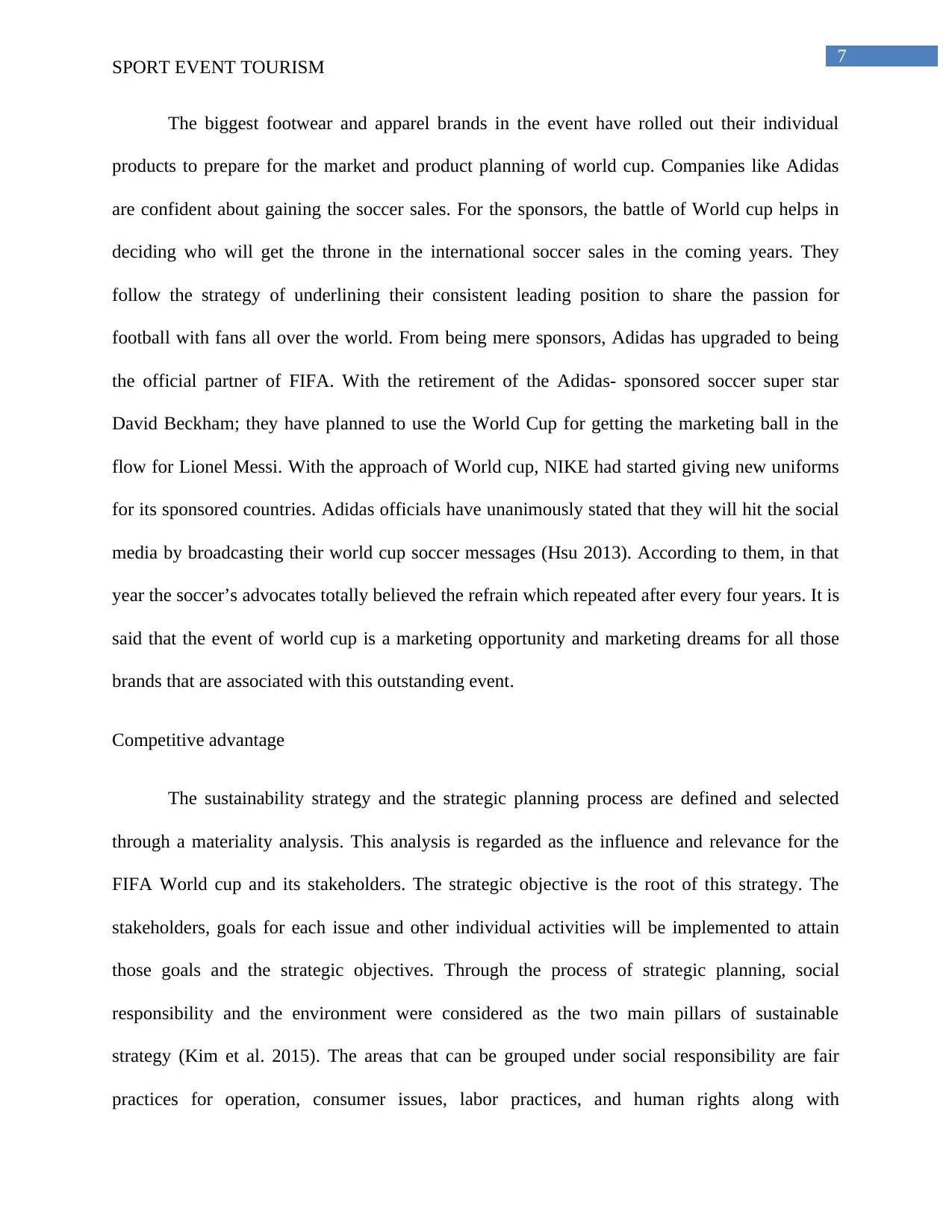
7
SPORT EVENT TOURISM
The biggest footwear and apparel brands in the event have rolled out their individual
products to prepare for the market and product planning of world cup. Companies like Adidas
are confident about gaining the soccer sales. For the sponsors, the battle of World cup helps in
deciding who will get the throne in the international soccer sales in the coming years. They
follow the strategy of underlining their consistent leading position to share the passion for
football with fans all over the world. From being mere sponsors, Adidas has upgraded to being
the official partner of FIFA. With the retirement of the Adidas- sponsored soccer super star
David Beckham; they have planned to use the World Cup for getting the marketing ball in the
flow for Lionel Messi. With the approach of World cup, NIKE had started giving new uniforms
for its sponsored countries. Adidas officials have unanimously stated that they will hit the social
media by broadcasting their world cup soccer messages (Hsu 2013). According to them, in that
year the soccer’s advocates totally believed the refrain which repeated after every four years. It is
said that the event of world cup is a marketing opportunity and marketing dreams for all those
brands that are associated with this outstanding event.
Competitive advantage
The sustainability strategy and the strategic planning process are defined and selected
through a materiality analysis. This analysis is regarded as the influence and relevance for the
FIFA World cup and its stakeholders. The strategic objective is the root of this strategy. The
stakeholders, goals for each issue and other individual activities will be implemented to attain
those goals and the strategic objectives. Through the process of strategic planning, social
responsibility and the environment were considered as the two main pillars of sustainable
strategy (Kim et al. 2015). The areas that can be grouped under social responsibility are fair
practices for operation, consumer issues, labor practices, and human rights along with
SPORT EVENT TOURISM
The biggest footwear and apparel brands in the event have rolled out their individual
products to prepare for the market and product planning of world cup. Companies like Adidas
are confident about gaining the soccer sales. For the sponsors, the battle of World cup helps in
deciding who will get the throne in the international soccer sales in the coming years. They
follow the strategy of underlining their consistent leading position to share the passion for
football with fans all over the world. From being mere sponsors, Adidas has upgraded to being
the official partner of FIFA. With the retirement of the Adidas- sponsored soccer super star
David Beckham; they have planned to use the World Cup for getting the marketing ball in the
flow for Lionel Messi. With the approach of World cup, NIKE had started giving new uniforms
for its sponsored countries. Adidas officials have unanimously stated that they will hit the social
media by broadcasting their world cup soccer messages (Hsu 2013). According to them, in that
year the soccer’s advocates totally believed the refrain which repeated after every four years. It is
said that the event of world cup is a marketing opportunity and marketing dreams for all those
brands that are associated with this outstanding event.
Competitive advantage
The sustainability strategy and the strategic planning process are defined and selected
through a materiality analysis. This analysis is regarded as the influence and relevance for the
FIFA World cup and its stakeholders. The strategic objective is the root of this strategy. The
stakeholders, goals for each issue and other individual activities will be implemented to attain
those goals and the strategic objectives. Through the process of strategic planning, social
responsibility and the environment were considered as the two main pillars of sustainable
strategy (Kim et al. 2015). The areas that can be grouped under social responsibility are fair
practices for operation, consumer issues, labor practices, and human rights along with
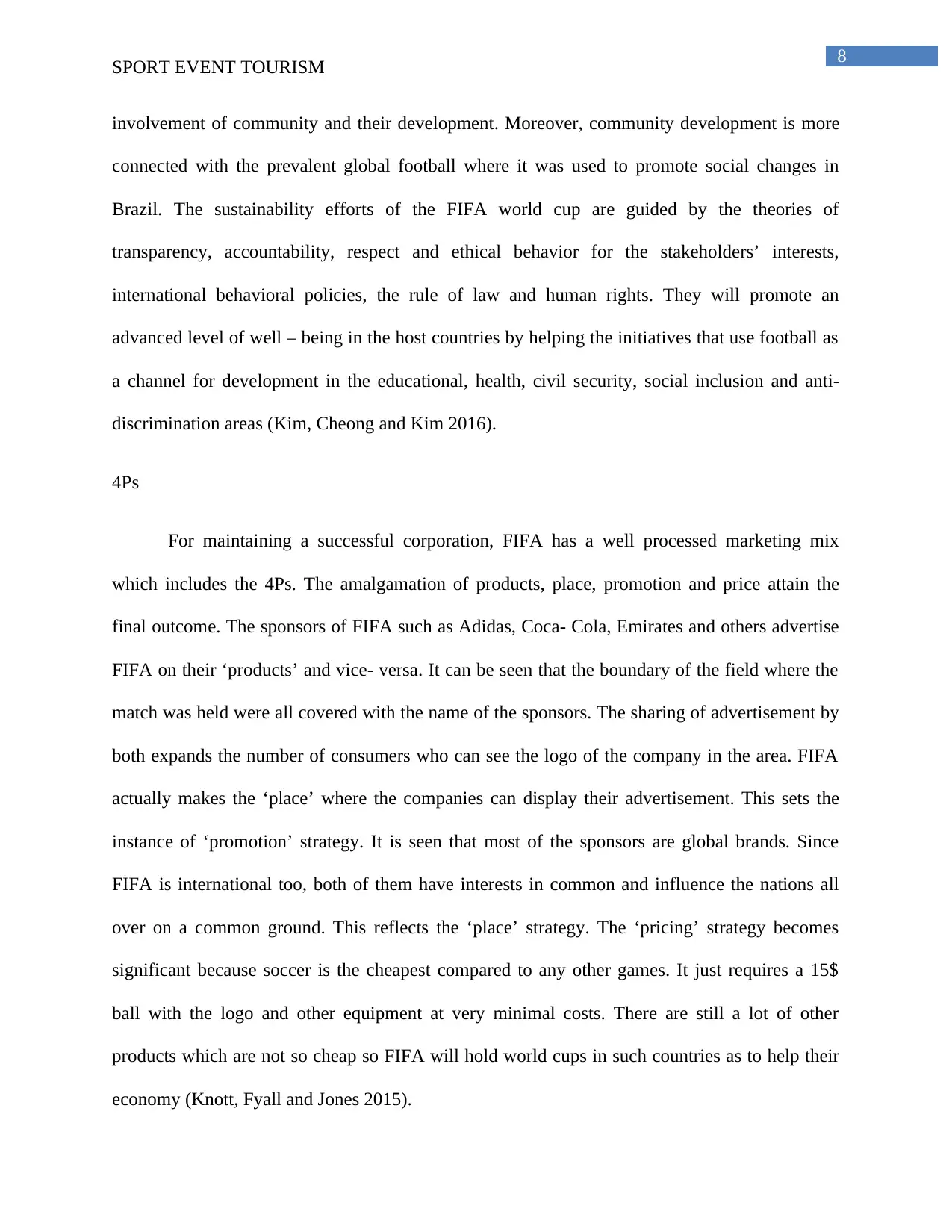
8
SPORT EVENT TOURISM
involvement of community and their development. Moreover, community development is more
connected with the prevalent global football where it was used to promote social changes in
Brazil. The sustainability efforts of the FIFA world cup are guided by the theories of
transparency, accountability, respect and ethical behavior for the stakeholders’ interests,
international behavioral policies, the rule of law and human rights. They will promote an
advanced level of well – being in the host countries by helping the initiatives that use football as
a channel for development in the educational, health, civil security, social inclusion and anti-
discrimination areas (Kim, Cheong and Kim 2016).
4Ps
For maintaining a successful corporation, FIFA has a well processed marketing mix
which includes the 4Ps. The amalgamation of products, place, promotion and price attain the
final outcome. The sponsors of FIFA such as Adidas, Coca- Cola, Emirates and others advertise
FIFA on their ‘products’ and vice- versa. It can be seen that the boundary of the field where the
match was held were all covered with the name of the sponsors. The sharing of advertisement by
both expands the number of consumers who can see the logo of the company in the area. FIFA
actually makes the ‘place’ where the companies can display their advertisement. This sets the
instance of ‘promotion’ strategy. It is seen that most of the sponsors are global brands. Since
FIFA is international too, both of them have interests in common and influence the nations all
over on a common ground. This reflects the ‘place’ strategy. The ‘pricing’ strategy becomes
significant because soccer is the cheapest compared to any other games. It just requires a 15$
ball with the logo and other equipment at very minimal costs. There are still a lot of other
products which are not so cheap so FIFA will hold world cups in such countries as to help their
economy (Knott, Fyall and Jones 2015).
SPORT EVENT TOURISM
involvement of community and their development. Moreover, community development is more
connected with the prevalent global football where it was used to promote social changes in
Brazil. The sustainability efforts of the FIFA world cup are guided by the theories of
transparency, accountability, respect and ethical behavior for the stakeholders’ interests,
international behavioral policies, the rule of law and human rights. They will promote an
advanced level of well – being in the host countries by helping the initiatives that use football as
a channel for development in the educational, health, civil security, social inclusion and anti-
discrimination areas (Kim, Cheong and Kim 2016).
4Ps
For maintaining a successful corporation, FIFA has a well processed marketing mix
which includes the 4Ps. The amalgamation of products, place, promotion and price attain the
final outcome. The sponsors of FIFA such as Adidas, Coca- Cola, Emirates and others advertise
FIFA on their ‘products’ and vice- versa. It can be seen that the boundary of the field where the
match was held were all covered with the name of the sponsors. The sharing of advertisement by
both expands the number of consumers who can see the logo of the company in the area. FIFA
actually makes the ‘place’ where the companies can display their advertisement. This sets the
instance of ‘promotion’ strategy. It is seen that most of the sponsors are global brands. Since
FIFA is international too, both of them have interests in common and influence the nations all
over on a common ground. This reflects the ‘place’ strategy. The ‘pricing’ strategy becomes
significant because soccer is the cheapest compared to any other games. It just requires a 15$
ball with the logo and other equipment at very minimal costs. There are still a lot of other
products which are not so cheap so FIFA will hold world cups in such countries as to help their
economy (Knott, Fyall and Jones 2015).
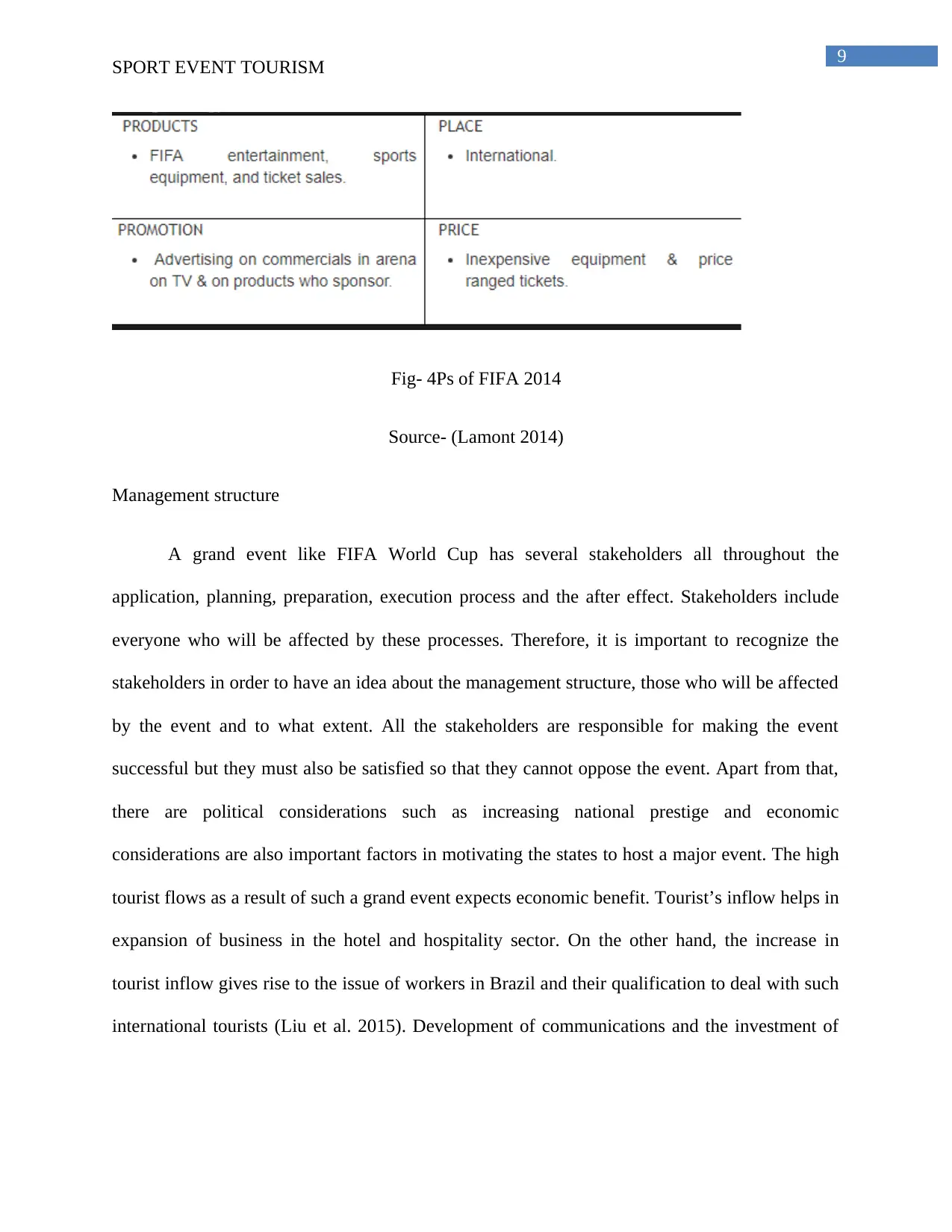
9
SPORT EVENT TOURISM
Fig- 4Ps of FIFA 2014
Source- (Lamont 2014)
Management structure
A grand event like FIFA World Cup has several stakeholders all throughout the
application, planning, preparation, execution process and the after effect. Stakeholders include
everyone who will be affected by these processes. Therefore, it is important to recognize the
stakeholders in order to have an idea about the management structure, those who will be affected
by the event and to what extent. All the stakeholders are responsible for making the event
successful but they must also be satisfied so that they cannot oppose the event. Apart from that,
there are political considerations such as increasing national prestige and economic
considerations are also important factors in motivating the states to host a major event. The high
tourist flows as a result of such a grand event expects economic benefit. Tourist’s inflow helps in
expansion of business in the hotel and hospitality sector. On the other hand, the increase in
tourist inflow gives rise to the issue of workers in Brazil and their qualification to deal with such
international tourists (Liu et al. 2015). Development of communications and the investment of
SPORT EVENT TOURISM
Fig- 4Ps of FIFA 2014
Source- (Lamont 2014)
Management structure
A grand event like FIFA World Cup has several stakeholders all throughout the
application, planning, preparation, execution process and the after effect. Stakeholders include
everyone who will be affected by these processes. Therefore, it is important to recognize the
stakeholders in order to have an idea about the management structure, those who will be affected
by the event and to what extent. All the stakeholders are responsible for making the event
successful but they must also be satisfied so that they cannot oppose the event. Apart from that,
there are political considerations such as increasing national prestige and economic
considerations are also important factors in motivating the states to host a major event. The high
tourist flows as a result of such a grand event expects economic benefit. Tourist’s inflow helps in
expansion of business in the hotel and hospitality sector. On the other hand, the increase in
tourist inflow gives rise to the issue of workers in Brazil and their qualification to deal with such
international tourists (Liu et al. 2015). Development of communications and the investment of
Secure Best Marks with AI Grader
Need help grading? Try our AI Grader for instant feedback on your assignments.

10
SPORT EVENT TOURISM
media in the world cup is a prime long-term opportunity and play the pivotal role to pose an
outstanding impact on the hosting of a great event and the reputation of the host country, Brazil.
Three-year forecast
It was predicted by the Brazil’s Ministry of Sports that the FIFA world cup 2014 is going
to be a cash cow for them. The economy of the country is forecast to grow by a minimum of $70
billion as they had hosted the world cup event. The amount is based on the public and private
investment of Brazil in infrastructure, increase in consumption and other activities in the services
sector and in the collection of tax. The event is expected to earn more than $30 billion in through
direct tax, $10 billion through indirect tax and an increase in the consumption of the local goods
and services by approximately $3 billion for the time period of the event. 600000 tourists are
expected to come to the venue which would generate an additional $2.5 billion for the country’s
travel industry. More or less, 3 million Brazilian tourists are predicted to travel throughout the
country to generate an amount of $3.5 billion for travel and tourism (Noel et al. 2017).
Conclusion
The use of three strategies by the sponsors in FIFA world cup 2014 made it a remarkable
event to be remembered for four years. The speed of reaching the consumers, the location to
expand market and inviting the sports person to be the partners of the brand provided a positive
outlook and the opportunity to create something new. The three strategies were supplemented by
highlighting on portfolio and corporate and digital culture. Sports tourism has come under the
radar of tourism industry as a result of their economic forces, technological innovations and
change in value and attitude. Although the sports tourism industry is restricted to certain areas
but they can infiltrate economic, cultural and environmental areas.
SPORT EVENT TOURISM
media in the world cup is a prime long-term opportunity and play the pivotal role to pose an
outstanding impact on the hosting of a great event and the reputation of the host country, Brazil.
Three-year forecast
It was predicted by the Brazil’s Ministry of Sports that the FIFA world cup 2014 is going
to be a cash cow for them. The economy of the country is forecast to grow by a minimum of $70
billion as they had hosted the world cup event. The amount is based on the public and private
investment of Brazil in infrastructure, increase in consumption and other activities in the services
sector and in the collection of tax. The event is expected to earn more than $30 billion in through
direct tax, $10 billion through indirect tax and an increase in the consumption of the local goods
and services by approximately $3 billion for the time period of the event. 600000 tourists are
expected to come to the venue which would generate an additional $2.5 billion for the country’s
travel industry. More or less, 3 million Brazilian tourists are predicted to travel throughout the
country to generate an amount of $3.5 billion for travel and tourism (Noel et al. 2017).
Conclusion
The use of three strategies by the sponsors in FIFA world cup 2014 made it a remarkable
event to be remembered for four years. The speed of reaching the consumers, the location to
expand market and inviting the sports person to be the partners of the brand provided a positive
outlook and the opportunity to create something new. The three strategies were supplemented by
highlighting on portfolio and corporate and digital culture. Sports tourism has come under the
radar of tourism industry as a result of their economic forces, technological innovations and
change in value and attitude. Although the sports tourism industry is restricted to certain areas
but they can infiltrate economic, cultural and environmental areas.
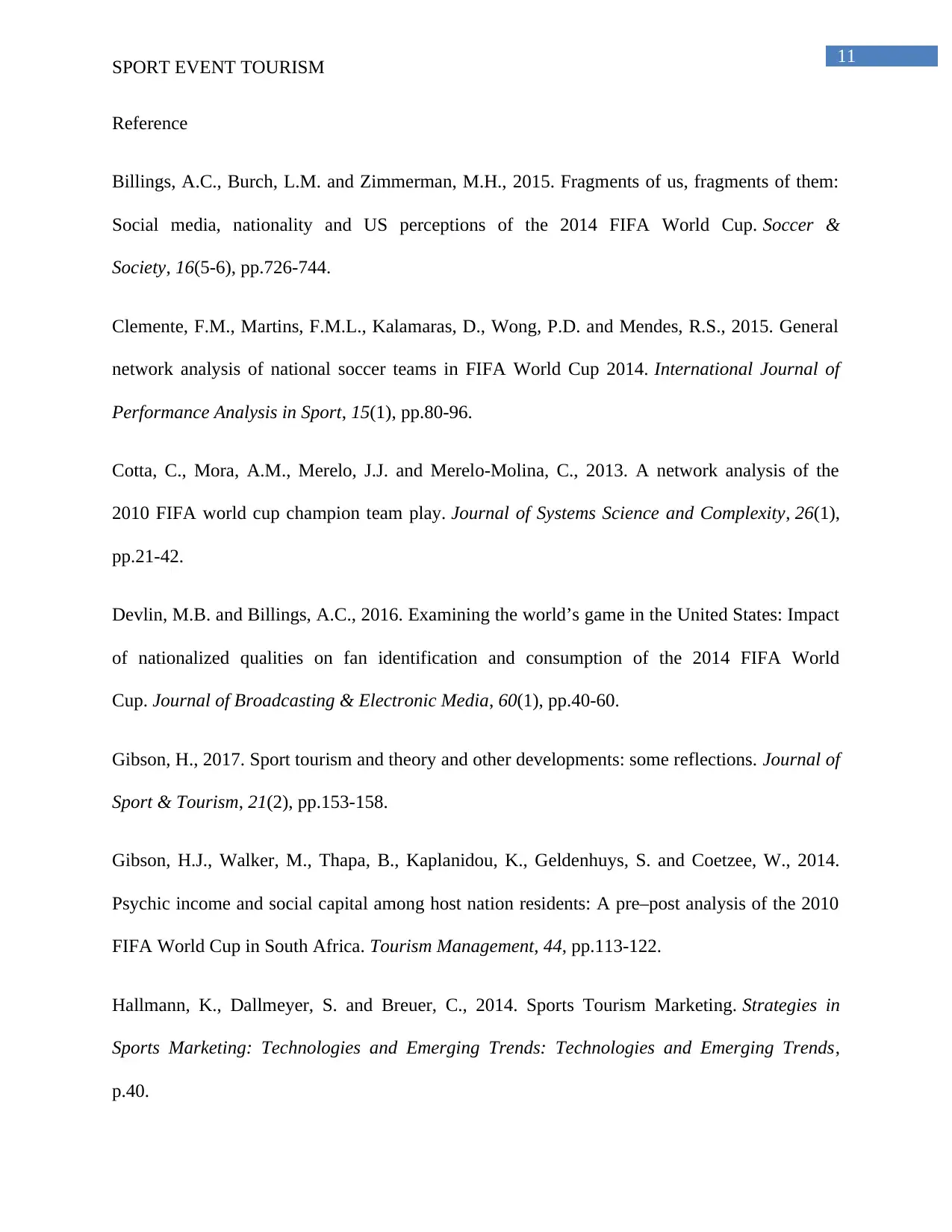
11
SPORT EVENT TOURISM
Reference
Billings, A.C., Burch, L.M. and Zimmerman, M.H., 2015. Fragments of us, fragments of them:
Social media, nationality and US perceptions of the 2014 FIFA World Cup. Soccer &
Society, 16(5-6), pp.726-744.
Clemente, F.M., Martins, F.M.L., Kalamaras, D., Wong, P.D. and Mendes, R.S., 2015. General
network analysis of national soccer teams in FIFA World Cup 2014. International Journal of
Performance Analysis in Sport, 15(1), pp.80-96.
Cotta, C., Mora, A.M., Merelo, J.J. and Merelo-Molina, C., 2013. A network analysis of the
2010 FIFA world cup champion team play. Journal of Systems Science and Complexity, 26(1),
pp.21-42.
Devlin, M.B. and Billings, A.C., 2016. Examining the world’s game in the United States: Impact
of nationalized qualities on fan identification and consumption of the 2014 FIFA World
Cup. Journal of Broadcasting & Electronic Media, 60(1), pp.40-60.
Gibson, H., 2017. Sport tourism and theory and other developments: some reflections. Journal of
Sport & Tourism, 21(2), pp.153-158.
Gibson, H.J., Walker, M., Thapa, B., Kaplanidou, K., Geldenhuys, S. and Coetzee, W., 2014.
Psychic income and social capital among host nation residents: A pre–post analysis of the 2010
FIFA World Cup in South Africa. Tourism Management, 44, pp.113-122.
Hallmann, K., Dallmeyer, S. and Breuer, C., 2014. Sports Tourism Marketing. Strategies in
Sports Marketing: Technologies and Emerging Trends: Technologies and Emerging Trends,
p.40.
SPORT EVENT TOURISM
Reference
Billings, A.C., Burch, L.M. and Zimmerman, M.H., 2015. Fragments of us, fragments of them:
Social media, nationality and US perceptions of the 2014 FIFA World Cup. Soccer &
Society, 16(5-6), pp.726-744.
Clemente, F.M., Martins, F.M.L., Kalamaras, D., Wong, P.D. and Mendes, R.S., 2015. General
network analysis of national soccer teams in FIFA World Cup 2014. International Journal of
Performance Analysis in Sport, 15(1), pp.80-96.
Cotta, C., Mora, A.M., Merelo, J.J. and Merelo-Molina, C., 2013. A network analysis of the
2010 FIFA world cup champion team play. Journal of Systems Science and Complexity, 26(1),
pp.21-42.
Devlin, M.B. and Billings, A.C., 2016. Examining the world’s game in the United States: Impact
of nationalized qualities on fan identification and consumption of the 2014 FIFA World
Cup. Journal of Broadcasting & Electronic Media, 60(1), pp.40-60.
Gibson, H., 2017. Sport tourism and theory and other developments: some reflections. Journal of
Sport & Tourism, 21(2), pp.153-158.
Gibson, H.J., Walker, M., Thapa, B., Kaplanidou, K., Geldenhuys, S. and Coetzee, W., 2014.
Psychic income and social capital among host nation residents: A pre–post analysis of the 2010
FIFA World Cup in South Africa. Tourism Management, 44, pp.113-122.
Hallmann, K., Dallmeyer, S. and Breuer, C., 2014. Sports Tourism Marketing. Strategies in
Sports Marketing: Technologies and Emerging Trends: Technologies and Emerging Trends,
p.40.
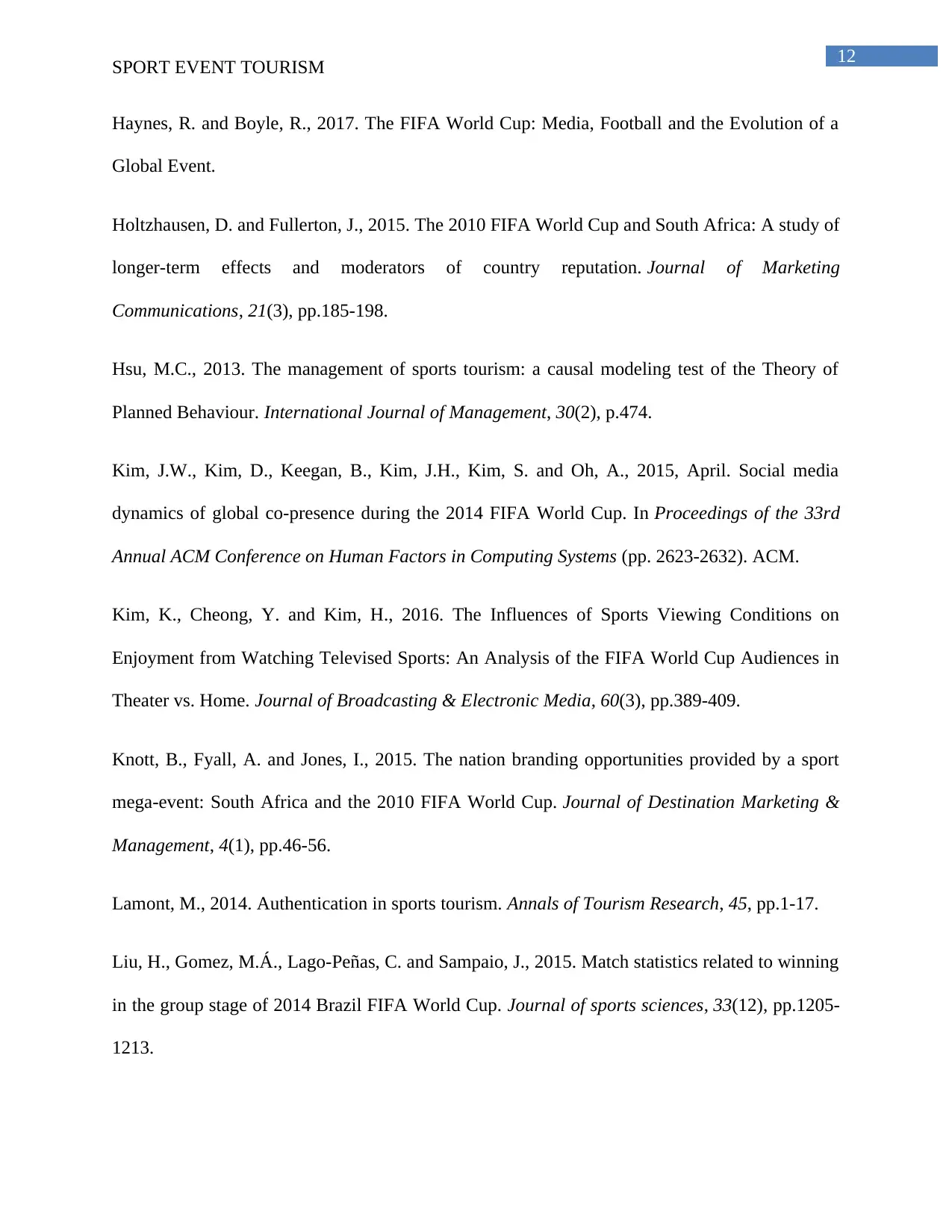
12
SPORT EVENT TOURISM
Haynes, R. and Boyle, R., 2017. The FIFA World Cup: Media, Football and the Evolution of a
Global Event.
Holtzhausen, D. and Fullerton, J., 2015. The 2010 FIFA World Cup and South Africa: A study of
longer-term effects and moderators of country reputation. Journal of Marketing
Communications, 21(3), pp.185-198.
Hsu, M.C., 2013. The management of sports tourism: a causal modeling test of the Theory of
Planned Behaviour. International Journal of Management, 30(2), p.474.
Kim, J.W., Kim, D., Keegan, B., Kim, J.H., Kim, S. and Oh, A., 2015, April. Social media
dynamics of global co-presence during the 2014 FIFA World Cup. In Proceedings of the 33rd
Annual ACM Conference on Human Factors in Computing Systems (pp. 2623-2632). ACM.
Kim, K., Cheong, Y. and Kim, H., 2016. The Influences of Sports Viewing Conditions on
Enjoyment from Watching Televised Sports: An Analysis of the FIFA World Cup Audiences in
Theater vs. Home. Journal of Broadcasting & Electronic Media, 60(3), pp.389-409.
Knott, B., Fyall, A. and Jones, I., 2015. The nation branding opportunities provided by a sport
mega-event: South Africa and the 2010 FIFA World Cup. Journal of Destination Marketing &
Management, 4(1), pp.46-56.
Lamont, M., 2014. Authentication in sports tourism. Annals of Tourism Research, 45, pp.1-17.
Liu, H., Gomez, M.Á., Lago-Peñas, C. and Sampaio, J., 2015. Match statistics related to winning
in the group stage of 2014 Brazil FIFA World Cup. Journal of sports sciences, 33(12), pp.1205-
1213.
SPORT EVENT TOURISM
Haynes, R. and Boyle, R., 2017. The FIFA World Cup: Media, Football and the Evolution of a
Global Event.
Holtzhausen, D. and Fullerton, J., 2015. The 2010 FIFA World Cup and South Africa: A study of
longer-term effects and moderators of country reputation. Journal of Marketing
Communications, 21(3), pp.185-198.
Hsu, M.C., 2013. The management of sports tourism: a causal modeling test of the Theory of
Planned Behaviour. International Journal of Management, 30(2), p.474.
Kim, J.W., Kim, D., Keegan, B., Kim, J.H., Kim, S. and Oh, A., 2015, April. Social media
dynamics of global co-presence during the 2014 FIFA World Cup. In Proceedings of the 33rd
Annual ACM Conference on Human Factors in Computing Systems (pp. 2623-2632). ACM.
Kim, K., Cheong, Y. and Kim, H., 2016. The Influences of Sports Viewing Conditions on
Enjoyment from Watching Televised Sports: An Analysis of the FIFA World Cup Audiences in
Theater vs. Home. Journal of Broadcasting & Electronic Media, 60(3), pp.389-409.
Knott, B., Fyall, A. and Jones, I., 2015. The nation branding opportunities provided by a sport
mega-event: South Africa and the 2010 FIFA World Cup. Journal of Destination Marketing &
Management, 4(1), pp.46-56.
Lamont, M., 2014. Authentication in sports tourism. Annals of Tourism Research, 45, pp.1-17.
Liu, H., Gomez, M.Á., Lago-Peñas, C. and Sampaio, J., 2015. Match statistics related to winning
in the group stage of 2014 Brazil FIFA World Cup. Journal of sports sciences, 33(12), pp.1205-
1213.
Paraphrase This Document
Need a fresh take? Get an instant paraphrase of this document with our AI Paraphraser

13
SPORT EVENT TOURISM
Noel, J.K., Babor, T.F., Robaina, K., Feulner, M., Vendrame, A. and Monteiro, M., 2017.
Alcohol marketing in the Americas and Spain during the 2014 FIFA World Cup
Tournament. Addiction, 112(S1), pp.64-73.
Porter, D., 2017. Foundations of managing sports events: organising the 1966 FIFA World Cup.
Sharma, B., Gursoy, D., Panosso Netto, A. and Ribeiro, M.A., 2016. Local residents' level of
trust, emotions, attachment, and support for the 2014 FIFA World Cup, Brazil. Proceedings of
the 6th Advances in Hospitality and Tourism Marketing and Management (AHTMM), pp.119-
128.
Slegers, C.A.D., Keuter, M., Günther, S., Schmidt-Chanasit, J., Van der Ven, A.J. and De Mast,
Q., 2014. Persisting arthralgia due to Mayaro virus infection in a traveler from Brazil: Is there a
risk for attendants to the 2014 FIFA World Cup?. Journal of Clinical Virology, 60(3), pp.317-
319.
Swart, K., George, R., Cassar, J. and Sneyd, C., 2017. The 2014 FIFA World Cup™: Tourists’
satisfaction levels and likelihood of repeat visitation to Rio de Janeiro. Journal of Destination
Marketing & Management.
SPORT EVENT TOURISM
Noel, J.K., Babor, T.F., Robaina, K., Feulner, M., Vendrame, A. and Monteiro, M., 2017.
Alcohol marketing in the Americas and Spain during the 2014 FIFA World Cup
Tournament. Addiction, 112(S1), pp.64-73.
Porter, D., 2017. Foundations of managing sports events: organising the 1966 FIFA World Cup.
Sharma, B., Gursoy, D., Panosso Netto, A. and Ribeiro, M.A., 2016. Local residents' level of
trust, emotions, attachment, and support for the 2014 FIFA World Cup, Brazil. Proceedings of
the 6th Advances in Hospitality and Tourism Marketing and Management (AHTMM), pp.119-
128.
Slegers, C.A.D., Keuter, M., Günther, S., Schmidt-Chanasit, J., Van der Ven, A.J. and De Mast,
Q., 2014. Persisting arthralgia due to Mayaro virus infection in a traveler from Brazil: Is there a
risk for attendants to the 2014 FIFA World Cup?. Journal of Clinical Virology, 60(3), pp.317-
319.
Swart, K., George, R., Cassar, J. and Sneyd, C., 2017. The 2014 FIFA World Cup™: Tourists’
satisfaction levels and likelihood of repeat visitation to Rio de Janeiro. Journal of Destination
Marketing & Management.
1 out of 14
Related Documents
Your All-in-One AI-Powered Toolkit for Academic Success.
+13062052269
info@desklib.com
Available 24*7 on WhatsApp / Email
![[object Object]](/_next/static/media/star-bottom.7253800d.svg)
Unlock your academic potential
© 2024 | Zucol Services PVT LTD | All rights reserved.





